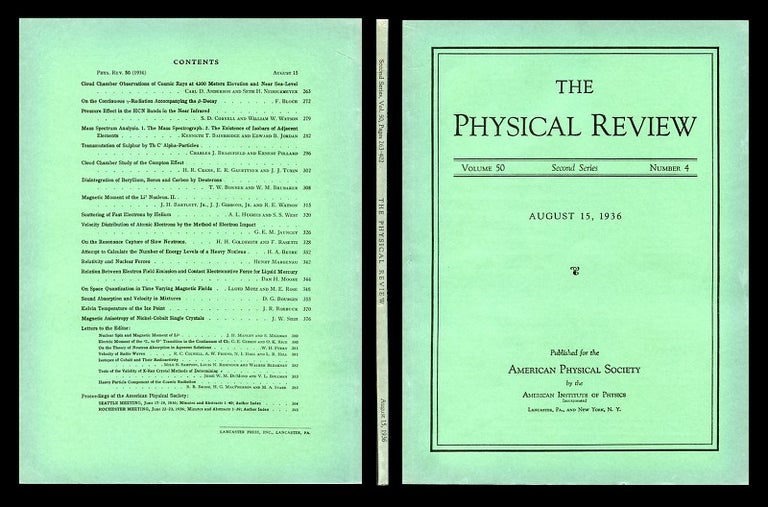An Attempt to Calculate the Number of Energy Levels of a Heavy Nucleus in Physical Review 50, 4, August 15, 1935, pp. 332-342 [1st edition ORIGINAL WRAPS: THE FIRST DERIVATION OF THE LEVEL DENSITY FOR A GAS OF FREE NUCLEONS
FIRST EDITION IN ORIGINAL WRAPS OF THE FIRST DERIVATION OF THE LEVEL DENSITY FOR A GAS OF FREE NUCLEONS.
“This expression, after suitably correcting for interactions present in actual nuclei, has been widely used to predict nuclear level densities” (Cook, Nuclear Level Densities, AJP, 20, 1967, p. 477). The nuclear level density “is the important quantity that may be used to describe thermodynamic properties nuclei, such as the nuclear entropy, specific heat, and temperature” (Dean, Pairing in Nuclear Systems, 9).
ALSO INCLUDED: Bainbridge, Kenneth T. and Edward B. Jordan “Mass Spectrum Analysis 1. The Mass Spectrograph 2. The Existence of Isobars of Adjacent Elements” in Physical Review 50, 4, August 15, 1935, pp. 282-296.
First edition in original wraps of the invention of the double focusing spectrometer. In 1936, Kenneth Bainbridge and Edward Jordan built a double focusing spectrometer at Harvard University. In 1919 Aston developed the first really good mass spectrograph, an instrument for measuring the masses of isotopes; his apparatus gave accuracies of one part in 1000. The mass spectrograph Bainbridge and Jordan developed was capable of mass determination of 1 in 30,000 parts. The earlier spectrographs were designed either to focus ions having the same velocity or moving in the same direction to one point (Mittal, Introduction to Nuclear, 29). In the instrument Bainbridge and Jordan built, greater accuracy was possible because “all the ions having same e/M value are focused at the same point irrespective of the direction or velocity” (ibid). Item #670
CONDITION & DETAILS: Lancaster: American Institute of Physics. 4to. 10.5 x 7.75 inches (262 x 194mm). Bound in original wraps. Bright and clean inside and out. Near fine condition.
Price: $125.00

